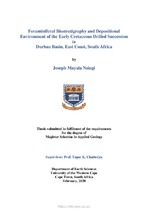| dc.contributor.advisor | Chatterjee, Tapas K. | |
| dc.contributor.author | Nsingi, Joseph Mayala | |
| dc.date.accessioned | 2020-09-15T12:36:11Z | |
| dc.date.issued | 2020 | |
| dc.identifier.uri | http://hdl.handle.net/11394/7326 | |
| dc.description | >Magister Scientiae - MSc | en_US |
| dc.description.abstract | Durban Basin located on the eastern coast of South Africa has been a focus of interest for Petroleum Exploration for the last few decades. Only four exploratory wells have been drilled in this offshore basin without success. During the initial stage of its creation, the basin suffered major tectonic disturbance as evident from the presence extensional faults followed by intense igneous activities. This was followed by marine sedimentation in the late Mesozoic (late Jurassic-early Cretaceous). An attempt has been made in this work to understand the distribution of the rock in space and time for the early Cretaceous sediments considered most prospective for hydrocarbon exploration in Southern Africa. Temporal distribution of planktonic foraminifera helps in identification of the three early Cretaceous (Barremian to Albian) stages within the drilled intervals. Foraminiferal biostratigraphic studies integrated with sedimentology, log motif analysis and seismic data analysis helps to predict paleodepth and depositional environment during early Cretaceous in this research. | en_US |
| dc.language.iso | en | en_US |
| dc.publisher | South African Journal of Higher Education | en_US |
| dc.subject | Foraminifera | en_US |
| dc.subject | Durban | en_US |
| dc.subject | South Africa | en_US |
| dc.subject | Early Cretaceous | en_US |
| dc.subject | Depositional environment | en_US |
| dc.title | Foraminiferal biostratigraphy and depositional environment of the early cretaceous drilled succession in Durban basin, east coast, South Africa | en_US |
| dc.rights.holder | University of Western Cape | en_US |
| dc.description.embargo | 2022-04-30 | |

